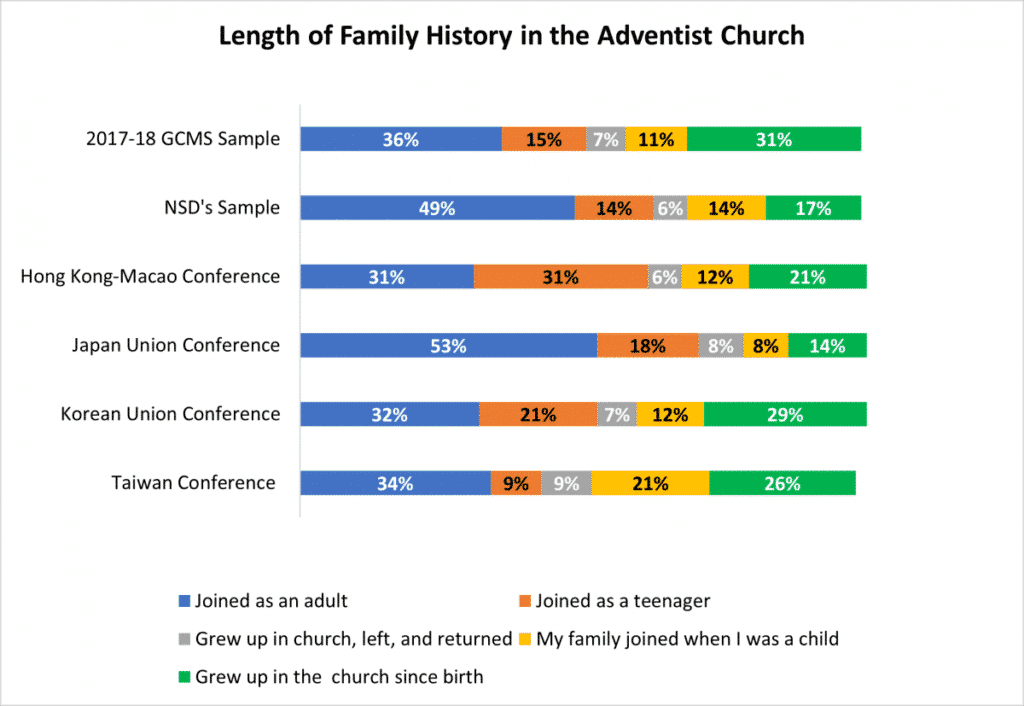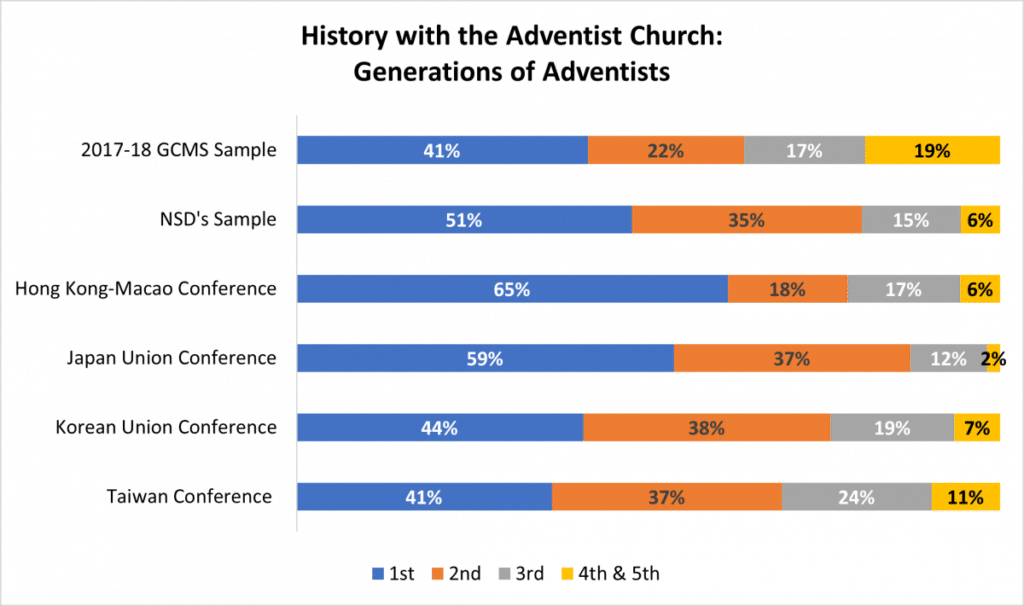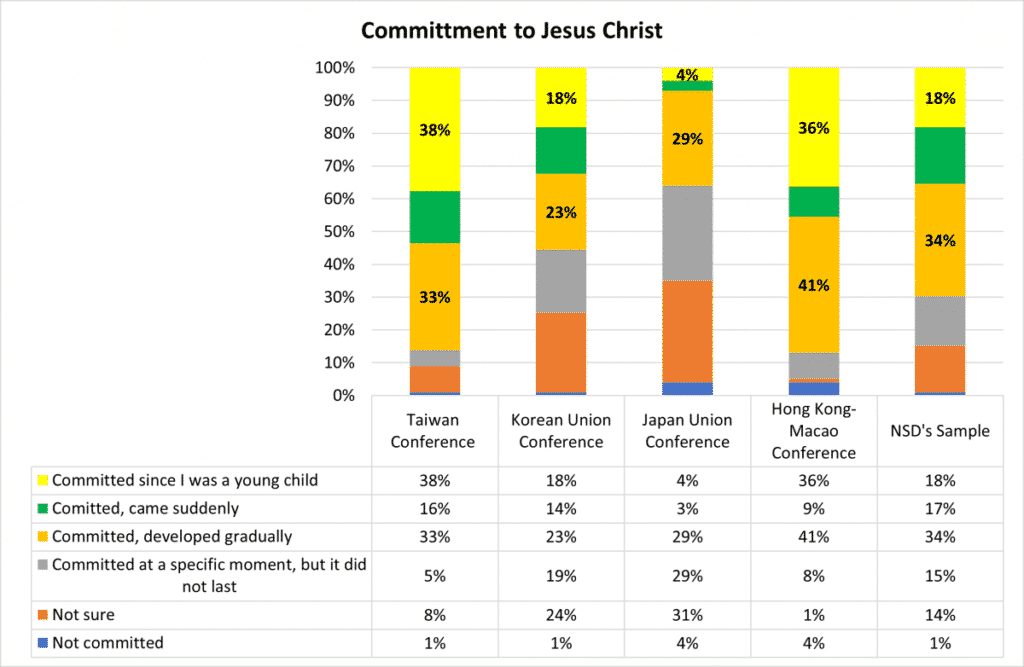What pictures do you have in mind when you hear about Japan, South Korea, Taiwan, or Hong Kong? Do you think about your favorite Asian dish, books you’ve read, movies watched? Or do you think of your dream to make a trip one day and see for yourself the colorful mosaics of various cultures and unique people groups?
In 2017, when the Global Church Member Survey (2017-18 GCMS) was conducted in all the Divisions of the Seventh-day Adventist Church, the Northern Asia-Pacific Division (NSD) supervised the Church work in Japan, South Korea, Taiwan, and other regions. Church members in these territories were included in the study, with a total sample of 3,064 participants. This blog will tell you about some challenges the Church and our fellow believers in NSD face in their spiritual journey.
The average (mean) age of the overall sample was 49. However, there was an age gap among Division Conferences, Unions, and Missions. The participants from Hong Kong were predominantly young, with 20% under the age of 26. In contrast, Japan’s sample was predominantly old, with 71% of respondents 56 years of age or older. Compared with other NSD Unions or Mission Fields, 27% more people in Japan were in the 56+ age category.
Interestingly enough, in NSD, almost half of the respondents (49%) joined the Adventist Church as adults, and about a third (31%) joined it either as children or grew up in the Church since birth. In comparing NSD’s and the 2017-18 GCMS samples, more adults joined the Church in NSD, but significantly fewer grew up in the Church from birth than in the total GCMS sample. Looking at the NSD Fields, the number of those who joined the Church as teenagers was the biggest in the Hong Kong-Macao Conference; it was also twice as much as in the overall GCMS sample. The Korean Conference had almost the same percentage of those who grew up in the Church as in the total GCMS sample, which shows that the Adventism there has deeper roots.

In addition to the question about the length of family history in the Adventist Church, the respondents were also asked about what generation of Adventists they belonged to. Across the Division, slightly more than half (51%) reported being first-generation Adventists. It was 10% more than in the overall 2017-18 GCMS sample. This points to a challenge for the NSD local churches to disciple these people without Adventist heritage or support from their families. This challenge is even more significant given the non-Christian context in the NSD Fields. At the same time, the other 50% of the respondents reported having at least one parent or grandparent who was a Seventh-day Adventist.
The differences across the Division highlight the Hong Kong-Macao Conference with almost two-thirds (65%) who were first-generation Adventists and the Japan Union Conference, 59%. The other two NSD Fields with a lower percentage of first-generation Adventists (which still is no less than in the GCMS sample) had the largest groups of those who grew up in the Church since birth or when their parents joined it. Notably, while the Japan Union had the lowest percentage of those who grew up in the Church when their parents joined it, the Taiwan Conference had the highest percentage. It also had the highest number of Adventists who grew up in the Church, left it for some time, but then returned.

Looking at such a complex picture of Church members’ history with Adventism in NSD, one wonders what they think about salvation through Jesus Christ and what kind of commitment they have to Him. The survey results showed that despite the non-Christian context and a focus on salvation through merits and good deeds in these cultures, 97% of the respondents agreed that salvation comes through Jesus Christ alone. The survey results showed that they had frequently heard about what Jesus had done for their salvation, and justification by faith was among the top three the most preached topics at their local churches: sermons about Sabbath (91%); on the second coming of Jesus (89%); on righteousness by faith (87%).
However, although justification by faith was not a strange topic for the Church members in NSD, and almost all believed that salvation comes through Jesus Christ alone, only 79% agreed that they had been saved at the moment they believed and accepted what Jesus had done for them, and about one-fifth (21%) disagreed or were unsure.
The researchers also examined different types of commitments to Jesus Christ. The data showed that gradual commitment that grew over the years was the largest category for the overall NSD sample. This reflects that this region has majority non-Christian populations in every country, where a low proportion of the population as a whole grew up knowing Jesus. Exceptions were the Taiwan Conference, where it was the second largest, and the Japan Union, where “I am not sure” was the largest category.
Another large group of respondents had been committed to Christ since they were young children. The Taiwan and Hong Kong-Macao Conferences led in this category. More than one-third of the participants in these Fields fell into this category, which indicates that there were many Adventist families with young children in the local churches. This possibly also points to the younger age of the survey participants and Church members in the samples and local churches in these Conferences. The lowest number of members committed to Christ since childhood was in Japan, which can be explained by a high percentage of those who joined the Church as adults and teenagers.

There were also people whose conversion came at a specific moment, but their commitment did not last, and they found themselves currently not committed to Christ as they had been before. The largest numbers of those were in the Korean and Japan Unions, which may be evidence of a need for a stronger emphasis on discipleship in these Unions. As a contrast, there was another category of members who experienced a sudden conversion which brought life changes and full commitment to Jesus. Interestingly, the percentage of this type of commitment increased with age and with the size of churches.
Combined results of the three “not committed” categories, showed significant percentages across the division territory. Interestingly, additional research showed that the percent of respondents who were not committed to Christ or were not sure about their commitment to Christ slightly increased with the length of time since baptism. This also is suggestive of a need for a stronger emphasis on wholistic, lifelong discipleship in the Northern-Asia Pacific region.
In conclusion, it is remarkable that the message about Jesus and salvation through Him alone has reached the various people groups in NSD, a stronghold of East Asian religions and traditions, including Shintoism and Confucianism, in which a billion people have been influenced by Communism, and in which materialism is also very influential, but the message of salvation in Christ has been preached in this challenging context. It is encouraging to know how many people have been touched by this good news and have committed their lives to Jesus with the courage of first-generation Adventists. It is also touching to see that Jesus finds people at different stages of their lives and uses different methods from sudden to gradual conversions. The research results also tell us that all categories listed in this study with their different family histories or commitments to Jesus are present in Adventist congregations. There are people who came to the Church with their unique stories about what Jesus had done for them and how they had met Him. These findings awake very important questions. Will the commitment of believers to Jesus last long? Will they grow in their personal walk with Jesus? Can we lose our commitment and assurance of salvation? Jesus said: “No man, having put his hand to the plough, and looking back, is fit for the kingdom of God” (Luke 9:62 KJV).
What can we and the Church do to help members who are new believers, young children, teenagers, and others grow in Him? How can each one of us stay strong and rejoice in Jesus?
See full 2017-2018 Meta-Analysis Report on the overall GCMS sample here.
Creado en colaboración con el Instituto del Ministerio de la Iglesia (Institute of Church Ministry).
Published by ASTR

